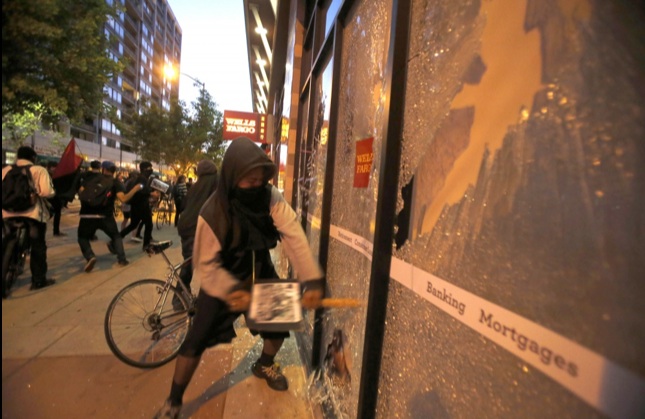|
|
Did The Mayor Actually Err?
June 4, 2015 If it was the intention of Mayor Libby Schaaf—as she indicated it was her intention—to put sudden and immediate restrictions on nighttime marches in Oakland in order to put a stop to the vandalism that so often has accompanied such marches in the downtown/uptown area in recent years, then it’s my belief that the mayor erred in her actions. I think the march restrictions will, in the end, make the brick-throwing and window-breaking and property-trashing more likely to continue, rather than less likely, at least in the short run. It’s an error, that is, if the vandalism was the mayor’s actual immediate target. But we’ll come to that in a bit. Meanwhile, how did we get to the point where the mayor felt the necessity to put restrictions on nighttime marches? The precipitating event, from all accounts, was an outbreak of vandalism centering around Oakland’s Auto Row following a series of overlapping May Day marches, protests, and demonstrations across the city that began early in the day and stretched into the evening hours. Oakland police estimated thousands of dollars in damage resulted, and the Associated Press quoted Police Chief Sean Whent as saying the destruction was "amongst the worst we had seen" in several months of downtown Oakland protest vandalism. A pattern of similar protest spinoff vandalism—groups mostly made up of young whites, many of them masked, that break off from organized marches to commit hit-and-run property damage—has been going on in the downtown/uptown area at least as far back as the original Oscar Grant demonstrations six years ago. During the Occupy era, these groups self-identified as anarchists, an identification that some long-established anarchist organizations and individuals who don’t support vandalism objected to. So to differentiate between these new groups and these objecting anarchist groups, let’s call these protest property vandals “vandarchists” for identification purposes, at least until they or someone else comes up with a more appropriate term. One thing that marks the Oakland vandarchists is that except for the FTP (“fuck the police”) marches they put together during the Occupy era, they rarely organize demonstrations themselves or go out and break business windows or trash cars when no demonstrations are taking place. Instead, they have generally been using the demonstrations as shield from which they then peel off to hit their targets. While it is not at all certain whether or not the vandarchists could operate in Oakland without the protective cover of demonstrations organized by others, it is without question that the vandarchists have been using that cover to great advantage over the past several years. And that has resulted in a decidedly mixed reaction from the organizations and demonstrators who have been—voluntarily or otherwise—providing the cover for them. Some demonstrators have argued that the vandalism is a minor distraction which the city, the public, and the media should generally overlook because it takes public attention away from the main causes that the organizations are demonstrating for. In the case of the marches in response to the national epidemic of the deaths of unarmed African-Americans at the hands of police, for example, the response of some demonstrators is that people should be more concerned about broken lives than with broken windows. That view among the non-vandalizing demonstrators is not universal, however, not by any means. At times, some demonstrators have confronted and argued with the vandalists, some even going so far as to attempting to physically prevent the destruction of property during demonstrations. One thing is clear, however. Whether the demonstrating organizations and the participating non-vandalizing demonstrators are ambivalent, symphathetic, or antaganistic to the vandalists, there can be no doubt that they are two completely separate entities. Ms. Schaaf might have found profitable areas of cooperation with the demonstration-sponsoring organizations to prevent vandalism at their demonstrations, as former Mayor Ron Dellums successfully did in cooperation with the Oscar Grant Movement following the chaos of the first night of demonstrations following Mr. Grant’s murder in 2009. While it is not at all certain that such an effort would have worked for Ms. Schaaf as it worked for Mr. Dellums, the new mayor’s actions in going after the demonstrations themselves—rather than after the vandarchists who are responsible for the property damage—practically assured that such cooperation will not be forthcoming in the near future, if at all. The breakdown in any trust between the non-vandalizing demonstration organizations and the Schaaf Administration—if such trust ever existed—was exacerbated by the fact that, according to longtime Oakland activist Pamela Drake, Ms. Schaaf chose to reveal a portion of her new strategy in advance to the Oakland business community, while springing it, unannounced, on the protest community in the middle of a demonstration. In addition, Ms. Schaaf’s actions in going after the demonstrations rather than the vandalists served to demonize the non-vandalizing demonstration organizations, making it appear to a good portion of the general public that it was they who were fomenting the property damage during the demonstrations, instead of a fringe element of vandalists. If you wanted a strategy for the mayor to deliberately piss off Oakland’s protest community, you couldn’t have devised a better one. What Ms. Schaaf’s action ensures—both the change in policy itself and the way it was introduced—is that protest demonstrations in Oakland in the immediate future will be more confrontational, therefore more chaotic, therefore providing more opportunity for the vandarchists take advantage of the situation, if they choose to do so. Does this mean that Ms. Schaaf erred—erred from her and the city’s point of view, that is—in taking her action against the demonstrations? But what if Ms. Schaaf’s actual purpose was to use the vandalism as an excuse to go after the demonstrations themselves? Since the death of Oscar Grant, after all, street demonstrations and marches have become a way of life in Oakland, giving the city a national reputation of activism rather than “welcome to investment” and “open for business” that Ms. Schaaf is trying to cultivate. If that were the case, violence and vandalism coming out of the mayor’s crackdown on nighttime marches would not be seen as a defeat of that policy, but would only open the way for further crackdowns. Is that what Ms. Schaaf is really trying to do in her revised nighttime protest rules? It’s certainly an interesting theory that invites further thought and analysis and discussion. But that discussion will have to wait for another time, as the time allotted for this one has, unfortunately, run out.
|


